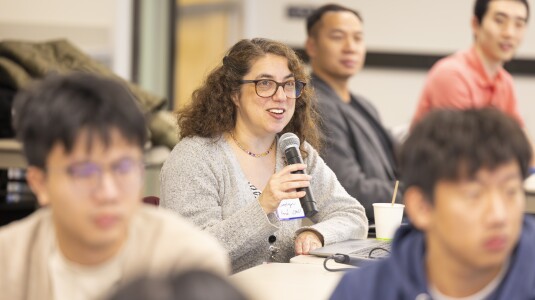With one of the largest, most diverse, most distributed workforces in the world, Amazon faces a unique HR challenge: how to deliver a work experience that supports the needs of every employee.
Jessie Handbury, an associate professor at University of Pennsylvania’s Wharton School and Amazon Visiting Academic (AVA), is helping Amazon’s People, Experience, and Technology Central Science Team (PXTCS) better understand and respond to the unique, diverse needs of Amazon employees in every corner of the world. In her role as an AVA, Handbury helps her PXT colleagues — who include economists, computer scientists and other scientists — research answers to complex questions.
Handbury was attracted to the AVA program by her mentor, Justine Hastings, the vice president of science who leads PXTCS. The two shared a research interest in public economics and industrial organization, and Hastings mentored Handbury in her early years as an assistant professor at Wharton. When Handbury received tenure at Wharton, Hastings invited her to join the AVA program and apply her economics expertise to help Amazon deliver a better, more equitable employee experience.
“Justine is thinking about how we can use science to make better business decisions as they relate to employees,” Handbury explains. “When she pitched it to me, it was, ‘How can we make Amazon employees' lives better?’ I think it was the combination of my background in applied economics and my work on spatial variation in prices, wages, and housing costs, generally, that matched Amazon’s needs.”
Today, she’s drawing on that extensive background to help craft a workplace experience that is truly valuable for Amazon employees across the globe.
“That’s the vision,” says Handbury. “How do we ensure work at Amazon is meaningful for employees and that they feel valued for their contributions and supported in their accomplishments? And how can we use Amazon’s scale to do that and use science, models, and economic data so we know what our employees need and we deliver it?” While the PXTCS team was researching these topics prior to Handbury joining as an AVA, her expertise has helped to accelerate those efforts.
One of the world’s most diversified workforces
Handbury works closely with the PXTCS team to design and roll out HR policies and programs that improve the experience of Amazon employees. With a research background melding labor and public economics, Handbury is well suited to help understand the varied needs of Amazon’s vast workforce.
Part of what we're trying to do is to recognize and understand the diverse skills, experiences, and goals of Amazon’s employees. We’re trying to find equitable ways to serve people with different preferences.
That background includes research in urban economics, industrial organization, and international trade that has helped policymakers and urban planners promote equitable urban development. She has also helped shed light on how local amenities, land-use regulations, and transportation policies shape urban development patterns, housing prices, and household location choices.
“Part of what we're trying to do is to recognize and understand the diverse skills, experiences, and goals of Amazon’s employees,” says Handbury. “We’re trying to find equitable ways to serve people with different preferences.”
Handbury and the PXTCS team employ data-driven tests and models to understand the unique needs of Amazon’s workforce, propose and test new solutions and offerings, gauge uptake and response, and predictably scale company-wide adoption. Handbury has expertise in spatial policies, which helps examine how a policy — whether from Amazon or government — might impact employees differently based on their location.
“Amazon needs to have employees in expensive cities like New York, Seattle, and San Francisco,” Handbury points out. “So what can Amazon do from an HR perspective to support those employees? And what can we, as scientists, do to represent the perspective of Amazon's employees and help provide benefits that make it easier for employees to live in those markets and work at Amazon?”
Examining open-enrollment rates
One example of Handbury’s data-driven approach at Amazon centers on the question of whether employees are opting into or updating their healthcare insurance options during open-enrollment periods and what might motivate those decisions.
“What we're working on now is to look at the data and examine how many Amazon employees are utilizing open-enrollment periods,” she explains. “We're looking at employee populations that tend to sign up more frequently versus those that do so less frequently and which have higher or lower participation rates."
That approach includes utilizing surveys to determine what factors may have played a role for employees who didn’t opt for insurance when they first joined Amazon.
“We are hoping to learn why didn’t they didn't sign up, to try and see which factors were most salient," Handbury says. "These responses will help inform whether the process itself is a barrier to enrollment. If, for example, new hires didn’t sign up because they found the process hard to navigate or found the plans hard to understand, we can work to fix those issues for when those employees engage again during open-enrollment periods. Once we have identified what the key barriers are, we will test interventions to address them.”
Handbury notes the answer might be as simple as employees not being aware they can make updates.
“For some employees, there's a stickiness to healthcare insurance decisions," she says. "They make the decision on whether to sign up for certain benefits, particularly health insurance and different health insurance programs, when they're first hired; they don't make adjustments during the open-enrollment period. Simple nudges to encourage employees to look at the benefit offerings during open enrollment would help employees whose healthcare needs have changed to re-optimize to better match their current needs.”
Another contributing factor may be found in the sometimes daunting task of parsing and comparing various healthcare options.
“Sometimes the language around health insurance programs can be difficult to understand, particularly when assessing exactly what the costs and benefits are,” she explains. “Is this something that could be improved with some better materials or by pairing employees with benefits experts who can help walk them through the sign-up process?”
Handbury notes that the answers to those questions are not trivial, either. “We’re figuring out whether we need to tailor the way that benefits are introduced to employees in a way that enables them to really reap the benefits that are being offered, should they want them.”
Explaining the world with models
Born and raised in Australia, Handbury came to the U.S. for university, in part because she wasn’t sure what she wanted to do after college.
“In Australia, most of the undergraduate degrees were professional,” she recalls. “The people who did well in high school would go into law or medicine. I didn't know what I wanted to do and was fortunate enough to come to America and ‘hit pause’ on that decision.”
Handbury became intrigued by data and models, which led to her pursuit of economics. During her undergraduate years at Columbia University, where she earned a bachelor’s in economics and mathematics, Handbury studied international trade and the underlying theories about how the economy works.
“The beauty of economics is you can explain what’s happening in the world with models. There are patterns in the data, and you can understand those patterns with simple, elegant theories,” says Handbury.
After stints at the U.N. and an economics consulting firm, Handbury returned to Columbia to pursue a PhD in economics. “I spent my early 20s playing with data — learning and modeling — and I realized that I wanted to go into research and get my PhD.”
Handbury says she thoroughly enjoys the collaboration with Amazon because it gives her more opportunities for mentorship. “It’s wonderful to be able to work with such a range of teams and a range of questions. A lot of our PhD students are going to become scientists and economists at large firms like Amazon.”
As far as advice she’d give to future scientists, Handbury keeps it simple: focus on what you enjoy. “Not every day is going to be fun, but for the most part you want your work to be something you look forward to sitting down to each day,” she says. “If you enjoy the journey you’re taking and the people you’re taking it with, then successful outcomes are just the icing on the cake.”




















